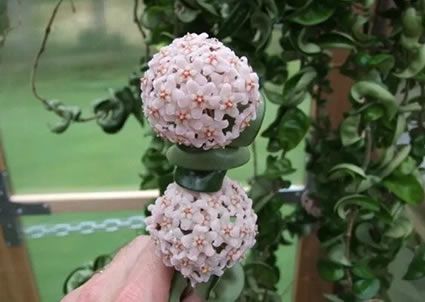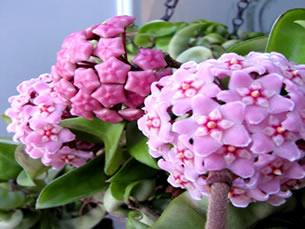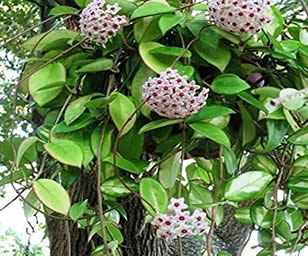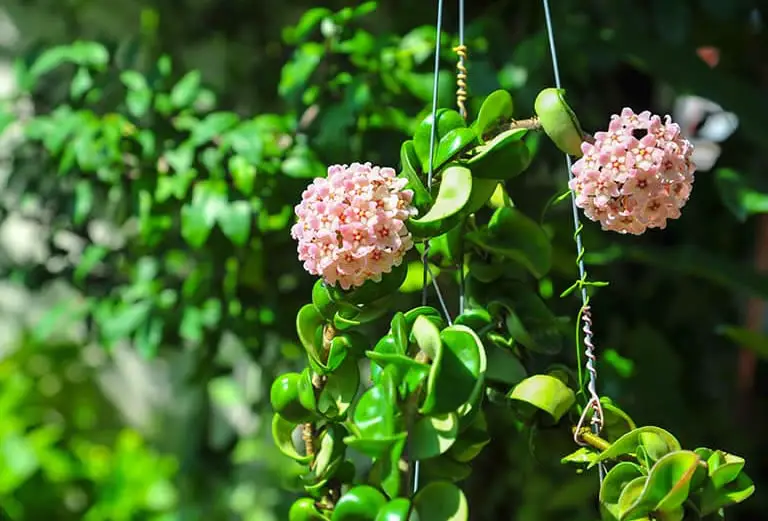Although I have mainly focused on the Hindu rope plant in this article the advice I give applies to all types of Hoya carnosa. Hoya carnosa compacta, the Hindu rope plant, is by far the most popular Hoya houseplant among my readers (at least those that contact me). So, I use this particular Hoya plant merely as a focus for the information.
Its long vines make the Hoya carnosa excellent for hanging baskets or as a potted plant on a high shelf and its perennial flowers are a beautiful pink. But many Hoya houseplant owners get frustrated when their plant simply refuses to bloom even after years in some cases.
In this article I will highlight reasons for non-blooming Hoya carnosa and what you can do to get your plant to produce those gorgeous flowers.
Table of Contents
How To Get A Hoya To Bloom The Easy Way
As previously stated, I will focus mostly on the Hoya carnosa compacta Hindu rope plant in this article but be aware that the information applies to all Hoya carnosa varieties. So regardless of the exact type of Hoya carnosa plant you have you will get valuable information that will help you get your plant to bloom.
Hoya carnosa compacta, also known as Hoya carnosa or as the Hindu rope plant, the curly wax plant and the Hoya rope plant (and sometimes a mixture of all of them), is a slow growing semi-succulent. Unfortunately as a slow growing vine it can take several years to see your first bloom if growing Hoya carnosa from seed or cutting.
However, if you have a mature Hoya carnosa houseplant that refuses to bloom then I am aware that it can be very frustrating waiting for those flowers to emerge. So, below are instructions for ensuring your plant produces some blooms this year. It is all down to the care you give to the plant.
Be sure not to skip any of the care steps outlined as this will give your plant the best chance to bloom.
First off lets look at why will your Hoya carnosa is refusing to bloom.
The likely reason your Hoya is not blooming
Before I cover the methods you can use to make a Hoya carnosa bloom let’s examine first why the plant is not blooming.
The main reason Hoya carnosa does not bloom is that the plant is too young. It takes the a Hoya plant between 3 – 7 years to mature enough to bloom.
Additionally, mature plants will not bloom if their care routine is wrong, especially if they are getting the incorrect type of light, and/or insufficient light.
If you have a mature plant that has bloomed previously but refuses to bloom now this is a strong indication that there is a problem with your care routine.
The information below will help you get your plant back to producing flowers.

If you have a Hoya carnosa plant that is older than 3 years and you want to try to force it to bloom then you should review the information below to make sure your care routine is correct.
Although Hoya carnosa is an easy-care plant even the smallest of mistakes in the care of this unique semi-succulent can lead to a lack of blooms.
There is a chance you will be able to force the semi-succulent to bloom even if it is only a few years old but if after taking the steps outlined below your Hindu rope plant (or any other Hoya carnosa type) still does not bloom, do not worry your plant just needs more time to mature.
How to make Hoya bloom even if it never has before
If you have a plant that is older than 3 years, and definitely if you have a plant that is older than 7 years, that will not bloom then you will want to change your care routine in order to encourage the plant to flower.
Although there is a “secret sauce” to helping Hoya carnosa flower the fundamental key to getting Hoya carnosa to bloom is to make sure it is growing in optimal conditions.
The average home makes an almost ideal environment for the Hindu rope plant with only a few minor changes needed to be make to the area directly around the plant perfect – mostly to do with humidity.
Below are key points to observe when you want your Hoya carnosa to bloom:
- Give the plant the correct light in the right quantities.
- Use the correct soil.
- Ensure the correct temperature range is observed.
- Create localized high humidity around the plant.
- Maintain low moisture levels in the soil.
- Fertilize the plant every 2 weeks during growing season.
Correct light is essential for making a Hoya flower
Although the number one reason for Hindu rope plant and other Hoya carnosa plants not blooming is the immaturity of the plant, lack of light is a close second.
The Hoya carnosa can survive, and even continue to grow in size, in low light conditions but it will never bloom.
Although Hoya carnosa and Hindu rope plants should never be placed in a location that gets strong direct light, like a sun-facing window, it does require at least 4 hours per day of good strong indirect light. 6 hours is better.
In the image below you can see that the blooming Hoya carnosa Hindu rope plant is protected from direct sunlight by window roller blinds. This allows the plant to get ample indirect light while remaining protected from the UV rays that come with direct sunlight.
If you find that your Hoya carnosa vines are not increasing in length, in addition to the plant not blooming, then the plant is probably not getting enough light.
If your Hoya is not getting enough light due to a dim location or other factors, it is perfectly fine to use a grow light to give the plant a little extra help. If you want faster growth and better blooms consider using a T5 HO grow light.

Aim for between 4 – 6 hours minimum of indirect light per day. You can give the plant more than this as long as it is either indirect light or artificial light. Never give it direct sunlight.
Make sure the plant gets at least 8 hours of darkness each night i.e. do not run a grow light 24/7!
If you have a non-blooming Hoya check the soil
The Hindu rope plant is not a succulent, contrary to popular opinion, it is actually a semi-succulent.
As an epiphytic, an air plant that grows on another plant, the Hoya carnosa have evolved to need good airflow around its roots.
Growing naturally in the crevices of trees in its native habitat the Hindu rope plant, and other Hoya carnosa varieties, does not grow well in a regular terrestrial environment. This means you must plant Hoya carnosa in a very specific type of soil if you want to get the best from the plant.
In order to replicate the native environment, as best you can, it is necessary to give the plant a light soil that promotes good airflow and that is fast-draining.
Use the following ratio for mixing Hoya carnosa soil:
- 1 third part potting mix.
- 1 third perlite.
- 1 third pumice or oak bark.
Instead of perlite you can use vermiculite or oak bark if you want to, as they will offer the same benefits.
Do not use compost or potting mix on its own and do not use succulent soil on its own either. Hoya carnosa needs rich soil that is also fast-draining and airy. The pumice ensures there is good air flow around the roots of the plant.
Regulate the temperature around the Hoya to encourage blooming
The average American home has temperatures, around 70°F, that are perfectly fine for cultivating any type of Hoya carnosa. However, be sure that your home stays within the temperature range of 65°F – 80°F.
As I pointed out in the article about Hindu rope plant problems, swings in temperature can have a very detrimental effect on Hoya carnosa plants. So keep your Hoya away from drafty doors and windows and also away from refrigerator and freezer doors. Additionally, keep it away from heating vents too.
Make sure the temperature around your plant does not drop below 50° for sustained periods of time as the plant will suffer cold stress and not bloom.
Get your watering routine correct or the plant will never bloom
The watering schedule for your Hoya carnosa should be similar to your watering routine for any other succulents you own and not similar to evergreens or other regular non-succulent houseplants. Less is better.
This plant requires at least half the soil to dry out before you water it again. For most potted Hoya carnosa plants this equates to once every 2 – 3 weeks.

To test the moisture in the soil use the finger test that I have outlined many times on this website or simply buy a cheap moisture meter.
If using the finger test be sure to push your finger much further down into the soil so the tip of your finger is half way down the pot. If using a meter make sure the tip of the meter is at least half way down the pot.
The Secret Sauce For Hoya Blooms
When all other care requirements are met you can use a little “secret sauce” to help your plant bloom. To encourage a Hoya carnosa to bloom try giving it some fertilizer every 2 weeks (or every time you water the plant) during the growing season – prior to blooming.
If using regular plant fertilizer always make it up to half the strength that is recommended on the product label. This is important!
It is also a good idea to use a feed that is high in nitrogen. This plant needs higher nitrogen content than most other common houseplants and without it, it will struggle to bloom. Added nitrogen will give it a “bloom boost”. If you are using a regular feed you can add some nitrogen feed to the fertilizer to achieve this aim.
At a push you can use coffee grounds to give the soil additional nitrogen but don’t make a habit of it for reasons I have highlighted before.
Stop fertilizing your Hoya carnosa when buds appear! If you continue to fertilize the plant at this stage the buds will mostly likely fall off before they even have a chance to open.
Review our Hindu rope plant care guide for detailed instructions on all of the above points.
When you can expect to see results – Hoya bloom times
So now you know how to encourage flower growth on your Hoya carnosa you will want to know when these beautiful semi-succulent vines bloom.
Hoya carnosa bloom in spring or summer. However, it will take several years before this wax plant is mature enough to produce flower buds.
You should expect to see buds developing on a mature Hindu rope plant in spring or early summer.
The plant will then bloom in late spring or summer as long as it has had several years to mature.
As most Hoya owners who read this website own hindu rope plants man wonder what time of year Hoya Carnosa bloom.
The time of year that most Hoya carnosa bloom is spring or summer.

Keep in mind, a Hoya carnosa will only bloom after the plant has had time to mature. A plant younger than 3 years old is unlikely to bloom. Some plants take up to 7 years before they bloom – for example the Hindu rope plant, Hoya carnosa compacta, takes between 5 – 7 years before it produces its first bloom.
As Hoya carnosa can live up to 30 years or more waiting for the first bloom is well worth it as the plant will continue to bloom every year afterwards as long as it is given the correct care.
In fact Hoya Carnosa Krinkle 8 bloom will bloom continually throughout the year after its first bloom is complete.
How long you can expect your new Hoya flowers to last
Now you know how to get your Hoya carnosa blooming how but long can you expect those flowers to last?
On average Hoya carnosa flowers last a few weeks on the stem. Cut flowers will last a few days to a week though you can use vase feed to help prolong their lives. Some varieties of Hoya carnosa bloom continually so as one flower dies another blooms.
Depending on the species of Hoya carnosa you are cultivating, the flowers can last a few weeks or be continually renewed with new blooms so that the plant always has flowers on it.
The top 5 Hoya plants that bloom the most
There are 5 Hoyas that bloom the most, some of which are in constant bloom throughout the year.
The 5 Hoya plants that bloom the most are:
- Hoya Carnosa Krinkle 8 – The beautiful pink flowers give off a chocolate/cocoa-like scent and bloom continually throughout year.
- Hoya Species Affinity Burtoniae – The deep burgundy flowers on this plant bloom continually throughout the year.
- Hoya Rebecca – The pink and yellow flowers stay in continual bloom throughout the year.
- Hoya Lacunose – The white and yellow flowers stay in constant bloom all year.
- Hoya Sunrise – The leaves on a Hoya are quite unique and slightly two-toned with deep green that is flexed with light burgundy. The flowers are light pink and yellow and stay in continual bloom year-round.

